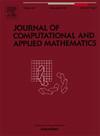二维NLSW方程线性隐式节能格式的无条件收敛性
IF 2.6
2区 数学
Q1 MATHEMATICS, APPLIED
Journal of Computational and Applied Mathematics
Pub Date : 2025-08-14
DOI:10.1016/j.cam.2025.117021
引用次数: 0
摘要
Hu等人(2023)最近提出了一种新的二维(2D)分数阶非线性Schrödinger波(NLSW)方程的线性修正节能方案,该方案在长时间计算中表现出高效率。然而,所提供的收敛性分析是有条件的,因为时间步长取决于近似空间的维数。本文旨在为二维NLSW方程建立一个与上述格式同样有效的无条件收敛的线性隐式节能格式。从理论上严格证明了离散修正能量守恒和唯一可解性。此外,提出了一种不受时间步长限制的最优离散L2收敛分析,其中利用“提升”技术解决了最重要的困难,即数值解的离散L∞估计。在数值方面,简要介绍了一种快速实现算法,并进行了若干数值实验,验证了理论分析和该方案的高效性。本文章由计算机程序翻译,如有差异,请以英文原文为准。
Unconditional convergence of a linearly implicit energy-conserving scheme for the 2D NLSW equation
A novel linear modified energy-conserving scheme for the Two-Dimensional (2D) fractional Non Linear Schrödinger Wave (NLSW) equation, recently proposed by Hu et al. (2023), demonstrates high efficiency in long-time computations. However, the convergence analysis provided is conditional, as the time-step size depends on the dimension of the approximation space. This paper aims to establish a linearly implicit energy-conserving scheme with unconditional convergence that is as efficient as the aforementioned scheme for the 2D NLSW equation. Theoretically, discrete modified energy conservation and unique solvability are rigorously proved. Furthermore, an optimal discrete convergence analysis is presented without any restrictions on the time-step size, where the “lifting” technique is utilized to address the most significant difficulty, i.e., the discrete estimate of numerical solutions. On the numerical side, a fast implementation algorithm is briefly outlined, and several numerical experiments are conducted to validate the theoretical analysis and demonstrate the high efficiency of our scheme.
求助全文
通过发布文献求助,成功后即可免费获取论文全文。
去求助
来源期刊
CiteScore
5.40
自引率
4.20%
发文量
437
审稿时长
3.0 months
期刊介绍:
The Journal of Computational and Applied Mathematics publishes original papers of high scientific value in all areas of computational and applied mathematics. The main interest of the Journal is in papers that describe and analyze new computational techniques for solving scientific or engineering problems. Also the improved analysis, including the effectiveness and applicability, of existing methods and algorithms is of importance. The computational efficiency (e.g. the convergence, stability, accuracy, ...) should be proved and illustrated by nontrivial numerical examples. Papers describing only variants of existing methods, without adding significant new computational properties are not of interest.
The audience consists of: applied mathematicians, numerical analysts, computational scientists and engineers.

 求助内容:
求助内容: 应助结果提醒方式:
应助结果提醒方式:


